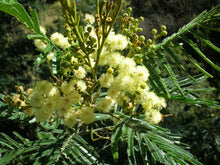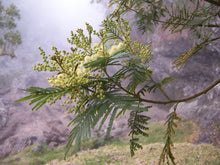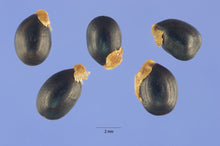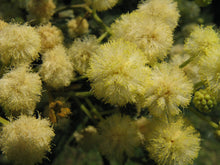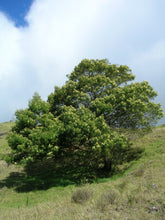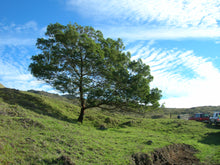
Scarification: Pour boiling water over seed , let stand in water for 24 hours, repeat process on seed that did not imbibe.
Stratification: none required.
Germination: sow seed 1/4" deep, tamp the soil, mulch the seed bed.
Other: if boiling water treatment does not allow seed to imbibe, sulfuric acid treatment is required.
A. mearnsii is native to south-eastern Australia and Tasmania, but has been introduced to North America, South America, Asia, Europe, Pacific and Indian Ocean islands, Africa, and New Zealand.
In its native range A. mearnsii is a tree of tall woodland and forests in subtropical and warm temperate regions. In Africa the species grows in disturbed areas, range/grasslands, riparian zones, urban areas, water courses, and mesic habitats at an altitude of between 600-1700m. In Africa it grows in a range of climates including warm temperate dry climates and moist tropical climates. A. mearnsii is reported to tolerate an annual precipitation of between 66 to 228 centimetres (26 to 90 in), an annual mean temperature of 14.7 to 27.8 °C (58.5 to 82.0 °F), and a pH of 5.0 – 7.2. A. mearnsii does not grow well on very dry and poor soils.
A. mearnsii plays an important role in the ecosystem in its native Australia. As a pioneer plant it quickly binds the erosion-prone soil following the bushfires that are common in its Australian habitats. Like other leguminous plants, it fixes the atmospheric nitrogen in the soil. Other woodland species can rapidly utilise these increased nitrogen levels provided by the nodules of bacteria present in their expansive root systems. Hence they play a critical part in the natural regeneration of Australian bushland after fires.
Ants harvest the seed, attracted by the fleshy, oil rich elaiosome (or seed stalk), which they bury and store in widely dispersed locations. These seeds are buried ready for germinating with the next soaking rains. However a "wattle seed-eating insect' which enjoys liquid meals using its proboscis-like injector to pierce the testa and suck out the embryo often reduces the seeds viability.
Leuco-fisetinidin, a flavan-3,4-diol (leucoanthocyanidin) and a monomer of the condensed tannins called profisetinidins, can be extracted from the heartwood of A. mearnsii.
A. mearnsii produces copious numbers of small seeds that are not dispersed actively. The species may resprout from basal shoots following a fire. It also generates numerous suckers that result in thickets consisting of clones. Seeds may remain viable for up to 50 years.
Stratification: none required.
Germination: sow seed 1/4" deep, tamp the soil, mulch the seed bed.
Other: if boiling water treatment does not allow seed to imbibe, sulfuric acid treatment is required.
A. mearnsii is native to south-eastern Australia and Tasmania, but has been introduced to North America, South America, Asia, Europe, Pacific and Indian Ocean islands, Africa, and New Zealand.
In its native range A. mearnsii is a tree of tall woodland and forests in subtropical and warm temperate regions. In Africa the species grows in disturbed areas, range/grasslands, riparian zones, urban areas, water courses, and mesic habitats at an altitude of between 600-1700m. In Africa it grows in a range of climates including warm temperate dry climates and moist tropical climates. A. mearnsii is reported to tolerate an annual precipitation of between 66 to 228 centimetres (26 to 90 in), an annual mean temperature of 14.7 to 27.8 °C (58.5 to 82.0 °F), and a pH of 5.0 – 7.2. A. mearnsii does not grow well on very dry and poor soils.
A. mearnsii plays an important role in the ecosystem in its native Australia. As a pioneer plant it quickly binds the erosion-prone soil following the bushfires that are common in its Australian habitats. Like other leguminous plants, it fixes the atmospheric nitrogen in the soil. Other woodland species can rapidly utilise these increased nitrogen levels provided by the nodules of bacteria present in their expansive root systems. Hence they play a critical part in the natural regeneration of Australian bushland after fires.
Ants harvest the seed, attracted by the fleshy, oil rich elaiosome (or seed stalk), which they bury and store in widely dispersed locations. These seeds are buried ready for germinating with the next soaking rains. However a "wattle seed-eating insect' which enjoys liquid meals using its proboscis-like injector to pierce the testa and suck out the embryo often reduces the seeds viability.
Leuco-fisetinidin, a flavan-3,4-diol (leucoanthocyanidin) and a monomer of the condensed tannins called profisetinidins, can be extracted from the heartwood of A. mearnsii.
A. mearnsii produces copious numbers of small seeds that are not dispersed actively. The species may resprout from basal shoots following a fire. It also generates numerous suckers that result in thickets consisting of clones. Seeds may remain viable for up to 50 years.





